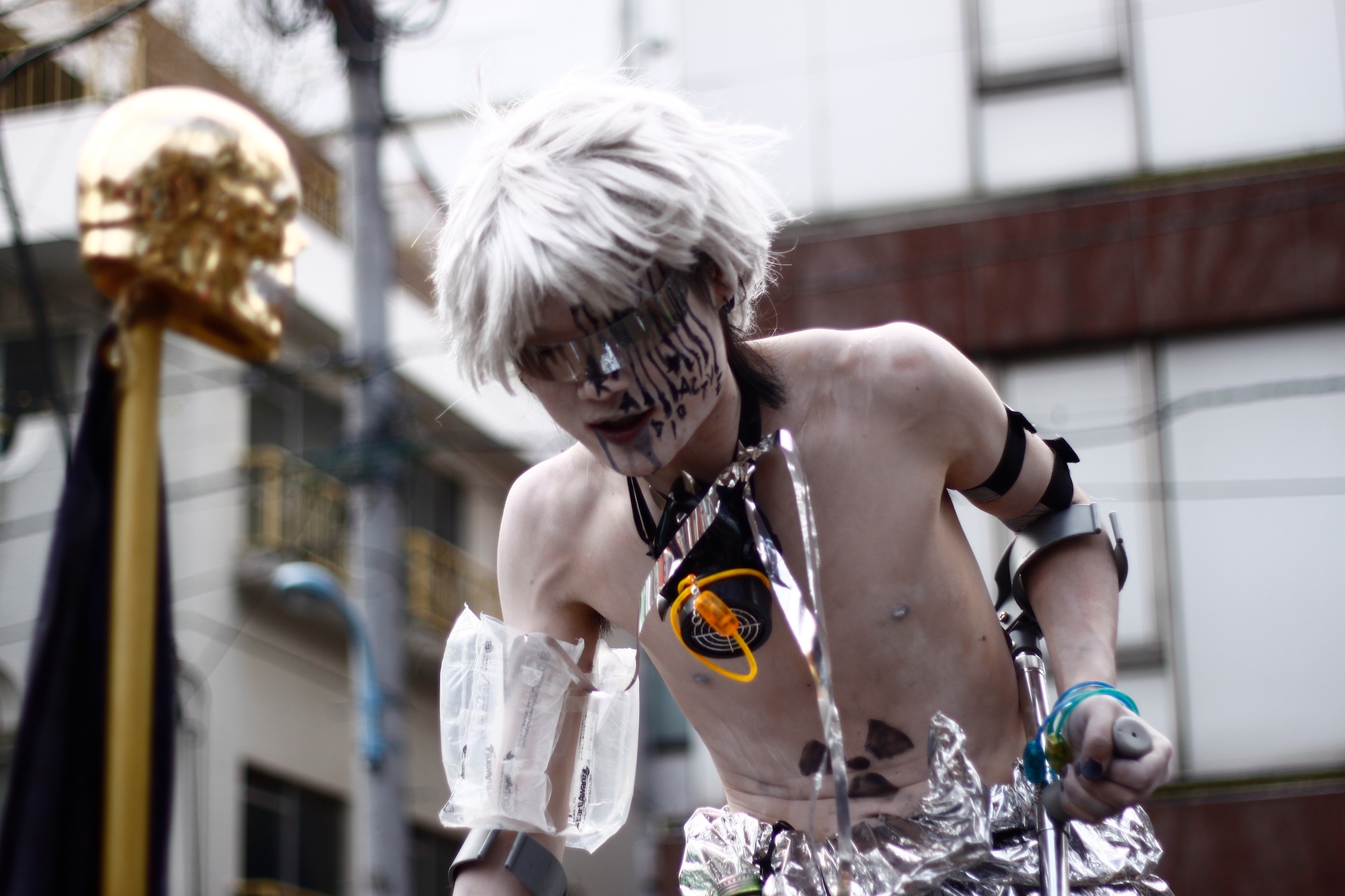A good definition of solidarity was provided by the critical theorist and ‘guru of the New Left’ Herbert Marcuse, who described it as a refusal to let one’s happiness coexist with the sufferings of others. Solidarity is readiness to make sacrifices for and share with others. It differs from mere compassion since it typically rests on a presumption of potential mutuality, based in a feeling of community or togetherness, of being comrades. When used in the context of social movements, solidarity usually also implies joint struggle against the cause of suffering or against a common adversary.

Anti nuclear power protests in Kouenji (2011). Photo by Matthias Lambrecht. Source: Flickr
A question often raised by philosophers and social thinkers is whether solidarity is being weakened in today’s individualized society. Must not individualization, grasped as a process through which individuals increasingly have to bear the responsibility for their own life-choices, also undermine the willingness to make sacrifices for others or for ideas of the common good? A common objection is that individualization does not necessarily imply increasing egoism, but may accompany increasing respect for individuals and human rights.Historically, it is possible to argue that the ideal of solidarity in modern society – or what the sociologist Hauke Brunkhorst calls ‘democratic solidarity’ – is typically solidarity between strangers, and that it has always presupposed a degree of individualization.
Even today there is much to support the view that individualization does not necessarily weaken solidarity, but rather shapes it in different ways. The political philosopher Jodi Dean, for instance, argues that we are moving towards a ‘reflexive’ solidarity, that builds on a communicative inclusion of strangers rather than on pre-existing communities or interests. Dean distinguishes this solidarity from two other, historically more prominent types, namely the ‘affective’ solidarity that arises between friends or in intimate relations, and the ‘conventional’ solidarity that builds on the common interests or history of groups. Unlike the letter forms of solidarity, the boundaries of reflexive solidarity are not determined by feelings, interests or traditions. It creates a mutable ‘we’ that forms in processes of communication, in which participants presume no more than that all will orient themselves responsibly towards the relation between them. The prominence of the ideal of global solidarity among new social movements can be understood as an expression of reflexive solidarity, in the sense that solidarity is not anchored in pre-existing communities or interests, but is instead mediated through communicative processes that make individuals identify with certain issues, such as climate justice or the support of refugees, for moral or other reasons.
However, while solidarity and individualization may coexist, solidarity need not take the ‘reflexive’ form that Dean hopes for. What might be called ‘individualized’ solidarity is simply a solidarity whose forms and objects are relatively detached from the institutional contexts, such as families, organizations, workplaces or state authorities, that have traditionally guided individuals’ sense of group belonging. That individualized solidarity is detached from such contexts does not mean that it rests solely on individual choices, only that the social contexts and interactions that shape it are not anchored in established institutions.
Its emergence may be stimulated by discourses that the individual happens to encounter in the media, on web forums or in associating with friends or acquaintances. Unlike the reflexive solidarity described by Dean, individualized solidarity is not necessarily open or inclusive. On the contrary, it may be bigoted and narrow-minded, such as when it is expressed in nationalism or racism. The rancorous tone used on certain web forums also shows that it is not necessarily reflexive in the sense of including a willingness to let oneself be influenced or re-shaped by arguments from others who think differently. Only by acknowledging the ambivalence of individualized solidarity can we grasp its limitations and possibilities, and see under which circumstances it may develop in a more open, inclusive and reflexive direction.
4chan and Trump
The ambivalence of individualized solidarity is well described in writer and artist Dale Beran’s analysis of how the internet forum 4chan – famously the birthplace of the hacker collective Anonymous – has become a stronghold for ‘the avant-garde of the far right’ and for Trump supporters. According to Beran, there are three types of Trump supporters. The first type are members of the ‘forgotten’ white working class, who place hope in Trump’s promise to ‘make America great again’. The second is the richest ‘one percent’, the elites who recognize the vacuity of that promise but who support Trump for the sake of their business interests. The third type are younger members of the remaining 99 percent who laugh at Trump’s incompetence and know that his promise is empty, but who support him ‘as a defiant expression of despair’ – as a show of contempt for a hypocritical system in which they have lost faith. The latter type, Beran suggests, is dominant among Trump supporters on 4chan, where it is symbolized by ‘Pepe the Frog’, a grotesque cartoon adopted as a mascot by the US alt-right. This attitude is not far off from cynicism, but what’s interesting is how it goes hand in hand with a form of solidarity.
According to Beran, 4chan users typically describe themselves as losers, as otaku or geeks who live in their parents’ basements and spend their days in front of their computers.
ejorative race and gender stereotypes proliferate along with jokes typically made at others’ expense. This jargon coexists with a celebration of ‘loserdom’, expressed in sympathy with losers and glorification of those who dare to ‘become a hero’, the forum term for committing suicide.
Many users happily spend time supporting people who in their view have been unfairly treated, helping them get revenge through trolling or other dubious methods. One example is Gamergate, a notorious harassment campaign initiated on the forum in 2014. Originating in the forum’s sympathy for a man who claimed to have been jilted by an unfaithful girlfriend, it quickly developed into a general attack on female game developers and the ‘politically correct’ gender ideology they were accused of introducing into the world of games. A certain highly emotional form of solidarity thus has a fertile ground in this forum, but it is ephemeral and ideologically ambiguous. The users’ willingness to stand up for freedom and justice can be expressed in Anonymous-style cyber-attacks as well as anti-feminist harassment campaigns, in support of the Occupy movement as well as of Trump.
One might be tempted to think of the Frankfurt School’s analysis of fascism as emerging from the insecure and atomized mass, prone to vent its rage on foreigners or minorities. In the wake of the 2008 finance crisis and the ensuing shock of austerity, Walter Benjamin’s account of the despair that in the 1930s caused the German middle class to seek salvation in authority figures seemed pertinent. But something is different. According to Beran, 4chan users don’t see Trump as a saviour, but support him because he is a ridiculous, incompetent loser just like them. One way of understanding the difference between 4chan users and the Hitlerite mass is to return to the concept of individualization and to Ulrich Beck’s theory of reflexive modernization. Unlike the National Socialist mass, 4chan users have no illusions about the possibility of resurrecting a wholesome, national community. Rather, they appear to accept individualization as irreversible. As Beran argues, they see themselves as losers in inevitable processes and scorn protests that nostalgically embrace the old. Their individualized solidarity thus appears to have run into a dead end. Does it really offer any possibilities of resisting the processes turning 4chan users into losers, and what new, more open or reflexive solidarities might possibly take form in it?
The individualized solidarity of otaku culture
Beran’s analysis of 4chan has clear antecedents in Japanese debates on otaku culture and the dissolution of social bonds. Indeed, 4chan was developed as a copy of Japan’s 2channel – one of the world’s largest internet bulletin boards – and much of the discussion on 4chan revolves around Japanese popular culture. Phenomena like otaku, dissolving communities, the increase of single households and isolated or socially withdrawn individuals have long been subject to discussion in Japan. Moreover, their political significance was also given attention at an early stage.
The sociologist Kitada Akihiro has argued that that 2channel constitutes a gigantic ‘closed public’ – formally open to anyone but characterized by an ‘internally closed’ jargon intended for initiates. Nationalism and ridicule of zainichi (the Korean minority) as well as the homeless proliferate, along with attacks on symbols of political correctness such as liberal newspapers like Asahi Shimbun or the country’s so-called ‘peace constitution’. According to Kitada, nationalist 2channel users see themselves as ‘high-minded patriots’ struggling against the establishment. However, this nationalism is mediated through ironic distance, resulting in a paradoxical mixture of cynicism and compassion. This ‘romantic cynicism’ is historically rooted in the disillusioned rejection of the student radicalism of the 1960s – a period designated as ‘the beautiful yesterday’. Romantic cynics see through the lies of politicians and other societal elites but have nothing but contempt for those who naively believe that social change is possible. As on 4chan, the laughter on 2channel is usually at the expense of others, yet the meanness coexists with a readiness to sympathize with underdogs. A good example of this was the profusion of advice that bubbled up on 2channel in 2004 in support of the so-called ‘train man’ (a young otaku who had fallen in love with a woman he had helped when she had been harassed on a train).
One explanation for the ease with which forum users move between seeming opposites is the absence of institutions capable of mediating between the individual and the larger world, an absence that allows the individual to identify directly with any myths or narratives by which they happen to experience themselves as interpellated. ‘The society that is supposed to mediate the relation between I and world appears not to exist’, Kitada writes about the forum discussions. Instead ‘a peculiar short circuit is established between existence and world’. Their individualized solidarity is directly oriented towards communities that are largely ‘imagined’, in other words collectives with whose members the individual lacks personal contact. However, unlike the ‘imagined community’ of the nation, the narratives or myths that Kitada talks about lack anchorage in established institutions. Instead they have a shifting and transient existence through the medium of popular culture, where they become a matter of individual choice.
Kitada doesn’t delve further into what drives individuals towards this type of institutionally un-anchored identification with imagined communities. Here the cultural critic and manga writer Ōtsuka Eiji contributes a more penetrating analysis, the basic framework of which he developed already in a work from 1989, Monogatari shōhiron (‘A Theory of Narrative Consumption’). According to Ōtsuka, the ‘worlds’ provided in manga or films are more important objects of consumption in otaku culture than the actual stories that are set in these worlds. When consumers buy popular cultural commodities they use their imagination to enjoy and explore these worlds. Ōtsuka finds the roots of this otaku culture at the end of the ‘political season’ of the 1960s and early 1970s. It was when revolutionary Marxism ceased to function as a credible meta-narrative that young people turned to the virtual worlds provided by popular culture as compensation. It is hardly a coincidence that both Ōtsuka and Kitada describe the aftermath of the student revolt in Japan as decisive to the emergence of new identifications and solidarities. More than in many other countries, the revolt of ‘1968’ in Japan is remembered as a traumatic defeat for the radical Left. For decades, this collective memory fuelled what has often been referred to as a ‘movement allergy’ and a preference for a ‘cool’, detached or ironic attitude among young Japanese. Only after the turn to the new millennium did open protest on a larger scale again become visible among young people in the country.
To Ōtsuka, this process is not directly linked to individualization. On the contrary, he stresses that the otakus’ worlds aren’t viable as merely private fantasies. Their subcultures involve the creation of new communities around alternative worlds derived from popular cultural works like Gundam, AKIRA or games like Dragon Quest. When the philosopher Azuma Hiroki criticizes Ōtsuka, it is in order to argue that these worlds are increasingly becoming fragmented and losing importance as objects of otaku desire. Instead, the visual appearance of characters themselves (known as kyara, an abbreviation of the word for character) is becoming central: these can be transposed more or less fortuitously between the various worlds provided in manga, films and games. Worlds, then, are becoming more individualized and individually eligible, and in that sense they may be becoming socially less important as a basis for otaku subcultures.
This floating and individually flexible orientation to objects of desire – whether these are worlds or characters – shouldn’t be confused with a development towards Dean’s reflexive solidarity. Characteristic of how individualization has become imprinted on Japanese subculture is, according to the sociologist Miyadai Shinji, that young people have retired into sheltered ‘islands’ rather than opening themselves reflexively towards strangers. The result is an ‘island universe’ (shima uchū) of isolated and specialized subcultures that have ceased to communicate with each other. Miyadai explains this development by referring to insufficient ‘communicative competence’. More precisely he sees the self-chosen isolation in these ‘islands’ as a reaction against the pressure to develop communicative and reflexive abilities that has become endemic in today’s complex society. This isolation needn’t be understood as an aversion to communication and reflection per se. Otaku or internet forum users can hardly be accused of lacking such abilities, considering the virtuosity of communication and the enormous store of specialized knowledge that they display when communication turns to their particular objects of desire. It is more apt to say that that theirs is a competence that fails to gain recognition from the surrounding mainstream society. Unlike the communication that Dean associates with reflexive solidarity, the communication prevalent in the ‘islands’ tends to be internal and based on all participants sharing the same narrative. It is this that gives rise to the otakus’ experience of being outsiders – not insufficient competence per se, but the fact that their competence is not rewarded by mainstream society.
Protest movements as associations
All this would suggest that individualized solidarity takes the form of ephemeral, institutionally unmediated identification with ‘imagined communities’ provided by popular culture, which in turn gives rise to relatively closed ‘islands’ that exclude strangers from communication. The return of protest movements in Japan in recent years offers another way to approach the problem of solidarity and movement activism in an individualized society. The Marxist philosopher Karatani Kōjin, who played a prominent role in the anti-nuclear power protests after the nuclear meltdown in Fukushima 2011, has explored the possibility of movements building on ‘free associations’ that avoid closure and homogeneity and instead provide room for difference, exteriority, singularity and openness. Between 2000 and 2003 he tried to launch a movement for ‘resisting capital, nation and state’ formed around the network the New Associationist Movement (NAM). NAM’s explicit ambition was to renew the organization and methods of anti-capitalist and anti-statist social movements. The idea was to utilize the process of individualization rather than resisting it. This was expressed in the preference for loose associations that were intended to be modelled on what Karatani calls ‘transcritical spaces’. Since such spaces are characterized by an existence in-between existing communities, they always transcend any single set of norms. The advantage of associations is that they are essentially structured around the interaction of strangers, just like capitalist markets. Such abstract and impersonal arenas would, he hoped, facilitate the participation of groups that had withdrawn from many existing forms of social belonging (including social withdrawers) or who had become disillusioned by existing forms of political activism.
In his recent works, Karatani discusses four kinds of exchange that have been significant throughout human history. The exchange of commodities on capitalist markets is the predominant form of exchange today. It differs from the mutual giving or sharing of gift economies characteristic of families and other closed communities, such as the ‘nation’, which in Karatani’s view is an attempt to preserve this form of exchange in modern society. A third type of exchange, one that is central to states and hierarchical relations, is that between submission and protection, which tends to take the form of tribute or taxes followed by redistribution. According to Karatani, these three kinds of exchange have become interwoven into a mutually reinforcing ‘trinity’ in the form of a symbiosis between capital, state and nation in modern society. Associations break with this trinity and constitute a fourth type of exchange that is characterized by both mutuality and openness. Even if they have never been historically dominant, they are anticipated in religious and social movements and recur through history in the form of egalitarian ideals with the potential to undermine and offer alternatives to the other, predominant types of exchange.
After the dissolution of NAM, Karatani continued to engage in various forms of activism. Since the nuclear disaster in Fukushima in 2011, Japan has been rocked by several large protest waves – not only against nuclear power but also against the nationalist programme promoted by the present conservative administration and in particular against the latter’s attempt to revise the country’s so-called peace constitution. The protests have helped visualize what Karatani means by associations. A fascinating part of these protests is the huge variety of narratives and imagined communities that they articulate. When one finds, for instance, a leading movement spokesperson describing how she sees the siting of nuclear plants in poor rural areas that were once sacred grounds as a continuation of the violent colonization of Japan by the Yayoi people – the invading forces in antiquity from which the present imperial house emerged – and that her mission is to resist this continuing invasion today, then we encounter a form of identification that is not essentially different from what one sees in otaku culture. Having come to her during meditation, this vision of history is as institutionally unmediated as the ‘worlds’ provided by popular culture.
However, in contrast to the isolation between subcultural islands in the ‘island universe’, the wave of movement mobilization in Japan in recent years has brought with it a coming together of people and a sharing of narratives that has gone hand in hand with forging new social bonds and creating new collectives. The stories and identifications do not remain as they are, in isolation, but interrelate, finding support in each other and becoming interwoven as mutually recognized parts of the wider movement. As Karatani writes, the demonstrations and protest actions can themselves be understood as associations or trans-critical spaces, where actors with different narratives – Buddhist priests, mothers from Fukushima, precarity activists, anarchists, liberal students, environmentalists and opposition politicians – meet, share space and talk to each other.
Movements as a way of encountering otherness
I have sketched two ways of approaching the possibilities of individualized solidarity. On the one hand there is the debate about the socially detached and often closed imagined communities of otaku culture and internet forums. On the other, there are attempts, guided by the idea of associations, to encourage open and inclusive solidarities created in actual encounters between people with different narratives. Whereas the former strand focuses on tendencies in internet-based interaction, the latter finds its moment of truth in the transient solidarities that become visible above all in protest movements. Both, however, illuminate the problem of individualized solidarity. However, while mobilizations in support of ‘losers’ like the ‘train man’ or as in Gamergate may resemble open, egalitarian and floating forms of coordination, they do not merit the term association if communication is limited to participants sharing the same narrative. To use Karatani’s terminology, associations must be ‘transcritical’ spaces that include difference. Following Dean, it is only in associations that a reflexive solidarity becomes possible, since it is only there that a ‘we’ can arise through communication with strangers.
Considering the popularity of pop-cultural references among activists in Japan today – evident for example in slogans, posters, cartoons, styles of clothing or movement mascots – it would seem obvious that elements from otaku or 2channel culture are numerous. Nevertheless, a decisive difference exists between the web forums and the protest movements. The difference consists neither in a break with the symbols, icons or stories of otaku culture, nor in the ideology framing these elements. Even in otaku culture, there is social criticism, solidarity with losers and indignation over injustice. The crucial difference is instead the presence in protest movements of a force that breaks with the closure of otaku culture, rooted in the fact that movements, especially in connection with large protest waves, offer a possibility of non-hierarchical encounters between people not sharing the same narratives and that new solidarities take shape in these encounters.
By way of conclusion, we can re-pose the question about whether individualization undermines solidarity. A common objection against this assertion has been that individualization merely transforms solidarity, making it more open, permissive towards individual differences and reflexive. However, nothing says that individualized solidarity has to become more open and inclusive. There is a risk that the increasing pressure on people to develop more reflexive forms of communication will create new losers. This risk is especially great if these reflexive forms of communication are interpreted as a functional supplement to the present system of capitalism, the very system that propels the process of reflexive modernization and whose logic – the relentless compulsion to accumulate capital – is exempted from the dissolving effects of the latter. The closed, insular solidarities on net forums like 4chan or 2channel may very well be interpreted as a protest against reflexive modernization from its self-designated losers, who despite their communicative abilities see themselves as deprived of a future. Closure could in that case be seen as a legitimate defence against a social development favouring the few and disfavouring the many. At the same time, it remains obscure how an alternative to capitalist logic is to be developed out of the individualized solidarity on these forums, especially since their participants are often deeply entangled in that logic through their very infrastructure.
There is, however, another way of responding to the fear that individualization will undermine solidarity. Social movements are not entirely dependent on existing solidarities, since, as Durkheim points out, they themselves produce solidarity, especially during great moments of effervescence when large numbers of people are mobilized and huge protest waves come into being. When people assemble and join forces around a common issue, they leave their everyday concerns and identities behind and enter new arenas of interaction where the encounters with strangers become possible. In these encounters, new feelings of belonging are created. A possibility of reflexive solidarity appears that is not submissive to the logic of capital or other dominant interests, but that solidarizes itself with the victims and makes their claims to justice its own. This solidarity may be ephemeral and unwittingly exclude people. Yet as a utopian ideal it has resurfaced again and again through history and remains a valid model for a solidarity possible even in individualized societies. To avoid exclusiveness, it needs self-criticism and reflexivity. In other words, we need to recall what Marcuse pointed out: that solidarity cannot let the happiness of some coexist with the suffering of others.







